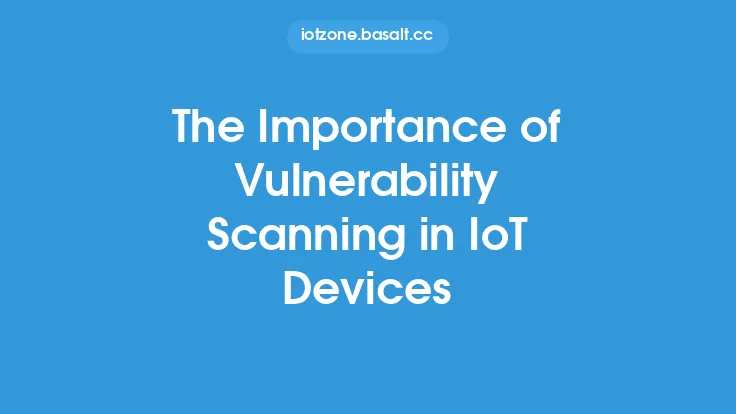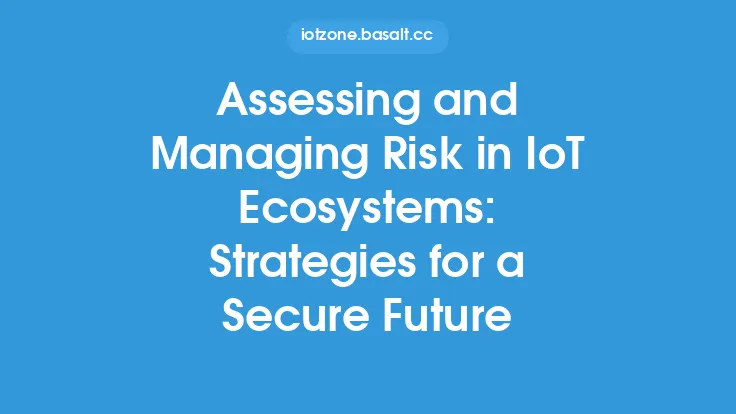The Internet of Things (IoT) has revolutionized the way we live and interact with devices, transforming everyday objects into smart, connected entities. However, this increased connectivity has also introduced a plethora of security risks, with device vulnerabilities being a significant concern. In IoT ecosystems, device vulnerabilities refer to the weaknesses or flaws in the design, implementation, or configuration of devices that can be exploited by attackers to compromise the security, integrity, or availability of the device or the entire network.
Introduction to Device Vulnerabilities
Device vulnerabilities in IoT ecosystems can arise from various sources, including hardware, software, and firmware components. These vulnerabilities can be inherent in the device's design or introduced during the manufacturing process. Some common types of device vulnerabilities include buffer overflows, SQL injection, cross-site scripting (XSS), and weak passwords. Additionally, the use of outdated or unsupported software, as well as the lack of secure coding practices, can also contribute to device vulnerabilities.
Types of Device Vulnerabilities
There are several types of device vulnerabilities that can affect IoT ecosystems. These include:
- Hardware vulnerabilities: These refer to flaws in the device's hardware components, such as processors, memory, or storage devices. Hardware vulnerabilities can be exploited to gain unauthorized access to the device or to extract sensitive information.
- Software vulnerabilities: These refer to flaws in the device's software components, such as operating systems, applications, or firmware. Software vulnerabilities can be exploited to compromise the device's security, integrity, or availability.
- Firmware vulnerabilities: These refer to flaws in the device's firmware, which is the software that controls the device's hardware components. Firmware vulnerabilities can be exploited to compromise the device's security or to gain unauthorized access to the device.
- Network vulnerabilities: These refer to flaws in the device's network communication protocols or configurations. Network vulnerabilities can be exploited to intercept or manipulate data transmitted between devices.
Causes of Device Vulnerabilities
Device vulnerabilities in IoT ecosystems can arise from various causes, including:
- Insecure design: Devices that are designed without security in mind can introduce vulnerabilities that can be exploited by attackers.
- Poor manufacturing practices: Devices that are manufactured with inadequate security controls or testing can introduce vulnerabilities that can be exploited by attackers.
- Outdated software: Devices that run outdated or unsupported software can be vulnerable to known exploits and attacks.
- Lack of secure coding practices: Devices that are developed without secure coding practices can introduce vulnerabilities that can be exploited by attackers.
- Inadequate testing: Devices that are not thoroughly tested for security vulnerabilities can introduce vulnerabilities that can be exploited by attackers.
Consequences of Device Vulnerabilities
The consequences of device vulnerabilities in IoT ecosystems can be severe and far-reaching. Some potential consequences include:
- Data breaches: Device vulnerabilities can be exploited to gain unauthorized access to sensitive data, such as personal identifiable information (PII) or confidential business data.
- Device compromise: Device vulnerabilities can be exploited to compromise the device's security, integrity, or availability, potentially leading to device crashes, data corruption, or unauthorized access.
- Network compromise: Device vulnerabilities can be exploited to compromise the entire network, potentially leading to a breach of the network's security, integrity, or availability.
- Financial losses: Device vulnerabilities can result in significant financial losses, either directly or indirectly, due to the costs associated with remediation, notification, and recovery.
Identifying and Mitigating Device Vulnerabilities
Identifying and mitigating device vulnerabilities in IoT ecosystems requires a comprehensive approach that involves multiple stakeholders, including device manufacturers, network operators, and end-users. Some strategies for identifying and mitigating device vulnerabilities include:
- Vulnerability scanning: Regularly scanning devices for known vulnerabilities and exploits can help identify potential security risks.
- Penetration testing: Conducting penetration testing can help identify vulnerabilities that can be exploited by attackers.
- Secure coding practices: Implementing secure coding practices can help prevent vulnerabilities from being introduced during the development process.
- Regular updates and patches: Regularly updating and patching devices can help fix known vulnerabilities and prevent exploitation.
- Network segmentation: Segmenting networks can help prevent the spread of malware and unauthorized access in the event of a device compromise.
Best Practices for Device Security
To ensure the security of devices in IoT ecosystems, several best practices can be followed, including:
- Implementing secure by design principles: Devices should be designed with security in mind, incorporating secure coding practices, secure protocols, and secure configurations.
- Conducting regular security testing: Devices should be regularly tested for security vulnerabilities, using techniques such as vulnerability scanning and penetration testing.
- Implementing secure update mechanisms: Devices should have secure update mechanisms in place, allowing for regular updates and patches to be applied.
- Using secure communication protocols: Devices should use secure communication protocols, such as encryption and secure authentication mechanisms.
- Monitoring device activity: Devices should be monitored for suspicious activity, allowing for quick detection and response to potential security incidents.
Future of Device Security
The future of device security in IoT ecosystems will depend on the ability of stakeholders to work together to identify and mitigate device vulnerabilities. Some emerging trends and technologies that will shape the future of device security include:
- Artificial intelligence and machine learning: AI and ML can be used to improve device security, detecting and responding to potential security threats in real-time.
- Blockchain: Blockchain technology can be used to improve device security, providing a secure and decentralized mechanism for device authentication and authorization.
- Quantum computing: Quantum computing will introduce new security risks, as quantum computers will be able to break certain types of encryption. However, quantum computing will also introduce new security opportunities, such as quantum-resistant cryptography.
- 5G networks: 5G networks will introduce new security risks, as the increased connectivity and speed will create new attack surfaces. However, 5G networks will also introduce new security opportunities, such as improved network segmentation and secure authentication mechanisms.





